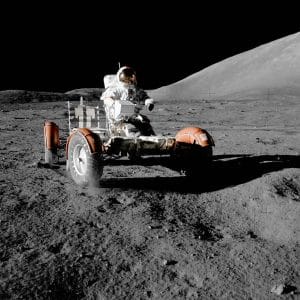Starting in the world of a wildly mixed heritage — he was born in Latvia to a father from a Baltic German noble family and a Scottish mother — von Tiesenhausen studied engineering in Berlin, and was drafted into the Wehrmacht and sent to the eastern front. But Germany decided his engineering was a better asset, and he returned to school, then was assigned to the Peenemünde Army Research Center, where he was assigned to Wernher von Braun’s rocketry team. After World War II, he was recruited by Operation Paperclip to work on rockets for the U.S., still on von Braun’s team, which transferred to NASA to work on the space program. For the Apollo era, “Von T” (as he was nicknamed) made a unique contribution: he designed the “LRV” or Lunar Roving Vehicle, for the Apollo 15, 16, and 17 moon crews. “He convinced von Braun we ought to design a moon buggy to go to the moon with the astronauts,” says NASA’s Ed Buckbee, the founding director of the U.S. Space & Rocket Center in Huntsville, Ala. “It took a lot of sales effort on the part of von Braun, von Tiesenhausen and others to convince headquarters that, ‘Look, we need to give those guys some legs on the moon. Give them the ability to extend their reach.’ And sure enough, we did. It really needs to be recognized. He put wheels on our American astronauts on the moon’s surface.”

“Apollo 17 built upon all of the other missions scientifically,” says Gene Cernan — the last man to walk on the moon. “We had a lunar rover, we were able to cover more ground than most of the other missions.” Apollo 17’s rover carried Cernan and geologist astronaut Harrison Schmitt nearly 36km (22.2 miles) across the lunar surface, allowing Schmitt to find a wide variety of rock samples to bring home. “We went to a more challenging unique area in the mountains, to learn something about the history and the origin of the moon itself,” Cernan says. When Von T was given a Lifetime Achievement Award for Education by the Space & Rocket Center in 2011, he was so respected by the astronauts that Neil Armstrong himself went to Huntsville to present it. “Dr. von T is one of those rare individuals who has a natural ability to inform and inspire, to educate and motivate, and, most remarkably, to endure,” Armstrong said at the time. “Science is about what is. Engineering is about what can be,” Armstrong, himself an aeronautical engineer, continued, and von T “is and has been a person who imagines what can be. And he has the skills to convert that imagination into reality. He is, in my opinion, an engineer.” Dr. von Tiesenhausen, the last of von Braun’s original German team, didn’t retire from NASA until 1986 — well into the Shuttle era. And even then, he volunteered to teach students at the Space & Rocket Center until 2010, finally retiring completely at age 96. He died at his home in Huntsville on June 3, at 104.
